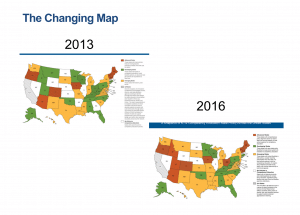The Field of CBE in Higher Education and K12
CompetencyWorks Blog
In this second article about exploring the world of CBE in higher education and K12, I focus in how the fields are developing.
Beginnings: In K12, the beginning of CBE usually starts with the innovations developed in the 1990s in Chugach, Alaska and in Boston with the launching of Diploma Plus and Boston Day and Evening Academy. (See the timeline of CBE in New England on page 12 of this report). In higher education, the roots of today’s CBE start earlier – in the 1970s (although I’ve seen the 1950s identified as a starting point).
Expansion: CBE in both sectors is expanding rapidly. There are currently 600 IHE providing or seeking to establish CBE programs. In 2015, approximately 200,500 students enrolled in CBE programs.
In K12-CBE, the landscape is changing. At the state level, every year finds more states establishing some type of initiative, and most of the states with seat-time policies that acted as barriers have found some way of allowing CBE. Our conservative estimates are that of the 135,000 districts in the United States, it is likely that 6 percent of them are implementing CBE at least in one school. However, no formal studies have been done to determine the numbers of schools and districts or their stage of implementation.

Policy: IHE and K12 are both shaped by federal policy, but in very different ways. IHE are heavily influenced by financial aid policy (see C-BEN report on financial aid). There are also laws on the books that are related to early 1900 correspondence courses being applied to online courses, including competency-based ones. The U.S. Department of Education is an engaged partner with the establishment of the Experimental Sites Initiative. Honestly, these policies and their impact have befuddled me at times and I don’t trust myself to summarize them for you. There are several pieces that can be helpful if you want to know more, including State Financial Aid Programs and Competency-Based Education, published by the Lumina Foundation, and Competency-Based Education and Federal Student Aid by Stephen Porter.
For K12, federal accountability policy was not a barrier, but it was an enormous weight on the traditional system, holding it into place. Accountability and other NCLB-related obstacles (please note, they have never been barriers that prevent CBE) have been reduced under ESSA if states are willing to do the work to take advantage of it.
When we started CompetencyWorks, we identified only one real barrier in state policy: seat-time credits that did not allow any alternatives. Today, CBE is allowable in most states, and one-third have put into place or are considering some type of policy or initiative to advance it. With ESSA, there is now much more opportunity to shape systems of assessments that are focused on helping students learn and schools improve rather than using up resources to report to the state and national levels. What’s important is that states and districts don’t allow the same-day, same-grade concept of equity that was developed under NCLB to limit the ability to meet students’ instructional needs. Although it sometimes feels like these rules are written in stone, they are not. It is up to us to design systems of assessments that inform locally-driven accountability rather than the absurd reporting, blaming, and shaming driven by governance needs.
Field-Building: The world of competency-based education in institutions of higher education took a different course to building the field than we did in K12. At CompetencyWorks, we wanted to have an open space for practitioners to learn from each other and to position ourselves for growth. We and others have written papers on a range of topics trying to draw knowledge together, but we have avoided being too precise about what it is and isn’t and have not yet tackled the issue of quality. The reason? We are in the midst of waves of innovation related to CBE, personalization, deeper learning, and blended learning. We don’t yet know how these pieces will best come together to shape what we might call K12 2.0.
In higher education, the Competency-Based Education Network (C-BEN) took the route of creating a closed consortium of leading colleges and universities. With frequent meetings over the year, the CBE leaders in higher education have built strong relationships and helped build knowledge. C-BEN has done a magnificent job in producing a set of reports to help other IHE to learn how to do CBE, including the Shared Design Elements and Emerging Practices.
– – –
Tomorrow we’ll look at Streamlining the Transition between K12 and Higher Ed.